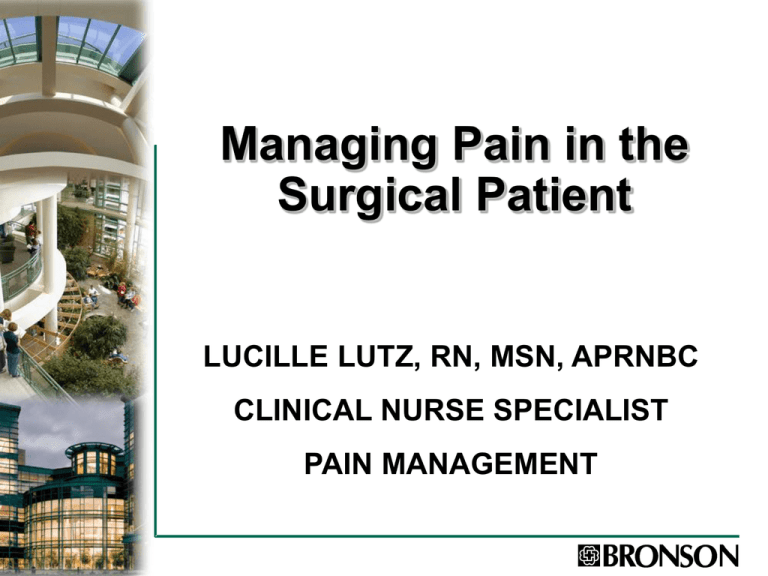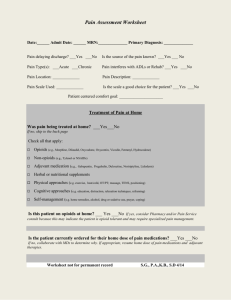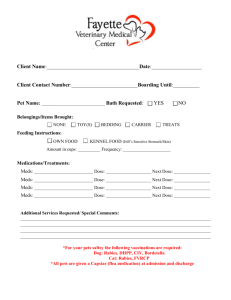Managing Perioperative Pain - Minnesota Hospital Association
advertisement

Managing Pain in the Surgical Patient LUCILLE LUTZ, RN, MSN, APRNBC CLINICAL NURSE SPECIALIST PAIN MANAGEMENT Objectives •Discuss preop pain assessment •Discuss intraop pain management •Discuss postop pain management Background Acute Pain • Immediate • Serves as a warning • Easier to treat (generally) • Has an end (generally) Background Chronic Pain • Lasts longer than 3-6 months • Serves no purpose • Cannot identify a cause • Can lead to pain behaviors • Very difficult to treat Pain Conduction •Injury triggers release of bio-chemicals •Inflammation takes place •Stimulation of nerve fibers •Bio-chemicals causes pain impulses to begin Pain Perception •Impulse is sent to the brain via ascending tracts in spinal cord •Neurotransmitters released by C fibers (substance P) •Message to the brain (Thalamus) •Sends message down descending pathway= pain response Why Pain Control •Persistent acute postoperative pain: •Decreases the body’s physiologic reserves •May exacerbate co-morbid conditions (e.g.) increase risk of MI in patients with CAD •Contributes to pulmonary complications. •Impairs rehabilitation and functional outcome • May lead to development of chronic pain syndromes and long-term disability. • Increases hospital stay and the cost of patient care • Decreases patient satisfaction. Metabolic Stress Response •Surgical insult results in post op pain •Increased circulating catecholamines •Resulting in tachycardia and hypertension •Leading to increased cardiac work •Resulting in increased myocardial oxygen consumption Cardiovascular • ↑ HR, ↑ BP, ↑ SVR, altered regional blood flow, ↑CMO2, ↑ DVT Respiratory: •– ↓ VL (atelectasis), ↓ cough (sputum retention) •– hypoxemia and infection Gastrointestinal: •– ↓ gastric and bowel motility, nausea, vomiting •• Genitourinary: urinary retention •• Neuroendocrine: ↑ catabolic hormones •– ↑ blood glucose, Na + H20 retention Musculoskeletal: Muscle spasm, immobility (↑ DVT) Psychological: fear, anxiety, insomnia •• Chronic pain Pre Op Assessment •Indication for surgical procedure •Allergies and intolerances to medications, anesthesia, or other agents •Known medical problems •Surgical history •Trauma (major) •Current medications (incl.OTC herbal & dietary supplements,and illicit drugs) Gayatri,P (2005). Post-op pain services. Indian J. Anaesth. 49 (1) : 17-19 •Discuss History of Acute or Chronic Pain •Identify history of pain control methods •What has worked •How long on pain meds •Do they work •True allergies, ask what happens •Differentiate between tolerance and physical dependence •Discuss pain management problems (ie) anxiolytic therapy with pain meds Identify if there is a need to wean from any pain medications prior to surgery •Do not stop suddenly •Consider Patients with: •Multiple back operations •Abdominal pain patients (ie) Crohn’s disease •Recurrent cancer •Chronic joint pain, (ie) RA or DJD •If with a history of chronic opioid use for pain management may require higher doses for pain control •This will include using PCA and/or meds for break through pain •May not get adequate relief with “standard” doses of “standard” post op pain orders • Do a directed pain history • Type of pain • Location, description, duration, exacerbation and relieving factors • Directed pain examination • Discussion of post-op pain control plan What about the Elderly •Evaluate each patient individually •Do not assume that aging is the same in all patients •Evaluate for side effects of narcotics •Need complete list of meds to check for interactions •Dispel myths • Concerns about opioids • Concerns about addiction • Fear of tolerance • Age related expectation of pain Pre Op Teaching Educate patient/family/staff • Pain plan • How & when to evaluate •Use of alternative methods of pain control •Patient and/or Family education on use of PCA •Explain blocks !!!!!! •Provide pre-anesthetic evaluation, brochures, and videotapes to educate patients about therapeutic options (music and/or guided imagery, other) Preoperative Preparation of the Patient Instruct on bedside postoperative evaluation Include instruction in behavioral modalities to control anxiety Distraction, deep breathing, visualization (etc) Preoperative Preparation of the Patient Instruct on pain ranking tools prior to surgery Use age appropriate tools, why, when and how to be used. Instruct S.O., parents if needed. May want to use personalized tool (i.e.Randall) •Generally there is decreased cardiac and pulmonary reserve with increased age •Opioids may produce confusion or cause some delirium postoperatively in some patients •An elderly patient taking six medications is likely to have adverse reactions 14 times more than a younger person taking the same number of medications. •Consider additive respiratory depressant effect of both opiates and anxiolytics •Most elderly patients metabolize drugs at a slower rate and may require lessfrequent dosing or a reduction in dosage •Certain medications should be avoided in elderly patients, based on their adverse effects •(Beers list) •Sedative effects with an increased risk of falls •Constipation related to opiates & NSAIDS • May have reduced gastrointestinal motility •Stool softener with stimulant •Start pain meds at a lower dose and increase to pain relief if opioid naive Special Populations Pediatrics • Use pain scales specific to age • FLACC (pre-op instruction) • Observe frequently • Medication dose wt specific • Guided Imagery • Distraction • Music/video Special Populations Pediatrics • Allergies • Sensitivities • Comfort frequently • If non verbal anticipate painful procedures result in pain • Be an advocate Special Populations Special needs: • Identify what works for this patient • Ask the family or caregiver • Comfort frequently • If non verbal anticipate painful procedures result in pain • Again be an advocate Cultural Considerations • Be aware of specific needs and beliefs • Respect the patient/family tradition • Internalize (how would I feel if) • Do not pre judge • Explain need for pain control Intra Op Consideration •Therapy selected should reflect the individual needs of the patient. •Ability to recognize and treat adverse effects during surgery •Special caution during continuous infusion modalities •Drug accumulation may contribute to adverse events •Patients who are pretreated with pain meds, anxiolytics or NSAIDS prior to surgery •Have a greater decrease in postoperative pain •Decrease in postoperative anxiety •Olorunto,W & Galandiuk, S. 2006. Managing the Spectrum of Surgical Pain: •Acute Management of the Chronic Pain Patient. American College of Surgeons •Surgeries to upper abdominal and thoracic areas associated with severe pain can lead to: • Restrictive lung defect • Depressed diaphragmatic activity Gayatri,P (2005). Post-op pain services. Indian J. Anaesth. 49 (1) : 17-19 Study: •Early and aggressive use of pain medications after surgery results in shorter hospital stays, fewer chronic pain problems later, and use less pain medication overall than people who avoid pain medication. Taylor, M. (2001).Managing postoperative pain. Hosp Med; 62: 560-563. Intra Op Consideration •Patient Advocate •Continue to assess for anxiety/pain •Provide comfort Positioning Guided Music imagery Adequately treating Post-surgical Pain • Increased Comfort =quicker healing • Increased activity= increased strength • Decreased complication= improved post-op period •The risk of addiction to pain medication is low for patients using such medications for post-surgical pain •Addictive personality leads to addiction •Dependency is another issue Effective Pain Control Listen to the patient • Believe the patient’s pain ranking Support the patient/family • Answer questions • Provide information Instruct re: need for pain control Sources of postoperative pain •Acute nociceptive pain from incision. • Musculoskeletal pain from abnormal body positioning and immobility during and after surgery • Neuropathic pain from excessive stretching or direct trauma to peripheral nerves Post Operative Pain Control Decreases risk of • Myocardial ischemia • Tachycardia and dysrhythmia • Impaired wound healing • Atelectasis • Thromboembolic events • Peripheral vasoconstriction Post Operative Pain Near the surgical site. •Acute exacerbation of pain may be added to the basal pain •Increases with activities such as coughing, turning, dressing changes •Generally self limiting •Progressive improvement over a relatively short period With Special Populations • Geriatric • Be aware of renal/hepatic function • Sensitivities/allergies • Be pro-active with medication • Opioids • Combination meds • Be aware of drugs to be avoided in the elderly ASSESS & RE-ASSESS • Before and after pain medications • Put it in the patient’s own words • Assess for non verbal cues • Be aware of special needs of the cognitively impaired patient • Use appropriate pain scale • Document, Document, Document, ASSESSMENT TOOLS • VAS • PAIN FACES • PAINAD • FLACC Post Op of Special Populations Geriatric • If with Cognitive Impairment • PAINAD scale • Observe & re-assess frequently • Guard/observe for delirium • superimposed on dementia • Know drug side effects • Know method of elimination Medication Use • Review information gathered during pre op assessment • If something has not worked in the past don’t use it. • Explain what you are doing and what you are giving • When in doubt, follow the WHO guidelines World Health Organization (WHO) 3- Step Ladder approach to pain management • Step 1- Mild Pain (1-3/10) • Nonopioid • Add adjuvant analgesic agent (i.e.) Ice, heat WHO cont’d • Step 2 Mild to moderate pain (4-7/10) • This step builds on step 1 • Treat with opioid combination drug • (hydrocodone/acetaminophen) • Watch ceiling effect of adjuvant drug • Peds are dosed by weight • Watch special needs patients/elderly WHO cont’d • Step 3- Severe pain (8-10/10) • Use opioids • Add adjuvant (i.e.)anti-anxiety,antiemetics, muscle relaxants • Start with short acting opioids to determine pain relief, breakthrough needs and frequency. • Switch to long acting use equianalgesic dosing chart for conversion POINTS TO REMEMBER • The pain intensity determines the step at which to begin. • Opioids are the only group of analgesics with no ceiling on dose with careful titration. • Most opioid side effects resolve within a few days. • Exception>>>>Constipation-- need to write for this immediately Commonly used first line opioids • Codeine • Morphine • Hydromorphone • Oxycodone Share the following characteristics • Half-life of immediate release preparations is 2 to 4 hours • Duration of analgesic effect between 4 to 5 hours when given at effective doses. • Sustained release formulations have duration of analgesic effect of 8 to 12 hours • Equianalgesic doses need to be calculated when switching from one drug to another • when changing routes of administration or both. • An equianalgesic table should be used as a guide in dose calculation • Due to incomplete cross-tolerance clinicians should consider reducing the dose by 20 to 25% when ordering. Morphine Onset: 15 to 60 minutes Peak Effect: 30 minutes to 1 hr Half Life: 1.5 to 2 hr IV: 0.05 to 0.1 mg/kg 5 minutes prior to procedure; max: 15 mg/dose Morphine Sedation, somnolence, respiratory distress or depression, pruritis Reversal: Naloxone: 5 to 10 mcg/kg/dose; Single dose should not exceed max recommended adult dose of 0.2 mg Fentanyl • Fentanyl is 80 to 100 times more potent than morphine. • Studies report less constipation and somnolence in patients using transdermal fentanyl compared to those using SR morphine. Fentanyl • Fentanyl’s high lipophilic properties provide a sufficient sublingual bioavailability of 90%, thus making it a suitable opioid for use sublingually. • Conditions that may effect absorption, bl levels & clinical effects if the drug • Morbid obesity • Ascites • opioid-naïve patients Fentanyl Onset: 1 to 5 minutes • Peak Effect: (no data available) • Half Life: 1.5 to 6 hr • IV: 0.5 to 3 mcg/kg/dose; may repeat after 30 to 60 minutes; max: 50 mcg/dose • Use lower doses (0.5 to 1 mcg/kg/dose) when used in combination with other agents, such as midazolam Fentanyl • Respiratory distress or depression, apnea, seizures, shock, chest wall rigidity (most likely to occur with rapid infusion or high doses) • Reversal: • Naloxone: 5 to 10 mcg/kg/dose; Single dose should not exceed max recommended adult dose of 0.2 mg Sufentanil • 5 to 10 times more potent than fentanyl. • Injectable sufentanil (like fentanyl) is readily absorbed through the mucous membranes • Early onset of action of about 5 to 10 minutes, when used sublingually Sufentanil • Good for incident pain control. • Peak analgesic effect of 15 to 30 minutes • Duration of the analgesic effect is 30 to 40 minutes. • Use for incident pain control, dosing 10 to 15 minutes prior to the painful event. Methadone • Long half life of methadone prevent it being a first-line opioid. • When converting to methadone dose reduction of 75 to 90% should be considered • Initiation for pain management is 5mg bid or tid depending on age Dilaudid 10mg IV morphine is equivalent to 1.32mg Hydromorphone IV Dilaudid has a half life of 2.5 hours, duration of effect varies Administering 1 mg or more of IV Dilaudid every 1 - 2 hours leads to a build up of the drug (stacking) and can increase adverse effects like respiratory depression. Know elimination Stacking from delayed peak effect Occurs when additional doses are given prior to peak effect leads to multiple doses, resulting in over dosage. Caution: Administration of a benzodiazepine with narcotic analgesics increases the risk of respiratory depression. (ie: Xanax, Lorazepam, Versed, Valium) Midazolam: CNS Depressant Onset: 1 to 5 minutes (short acting) • Peak Effect: 3 to 5 minutes (IV) • Half Life: 1.5 to 12 hr • Oral: 0.2 to 1 mg/kg; 30 to 45 minutes before procedure; max: 20 mg • IV: 0.05 mg/kg 3 minutes before procedure (may repeat dose X 2); max: 2 mg/dose Midazolam: CNS Depressant • Respiratory distress, depression, apnea, PVC's, amnesia, blurred vision, or hyperexcitibility Reversal: • Flumazenil:(Romazacon) 0.2 mg/dose q 1 minute; max cumulative = 1 mg POINTS TO REMEMBER • Dosing intervals are determined by the duration of action as well as the half-life of the drug • Know the route of elimination • Adjust dose and frequency for special populations. • Be aware of prior surgeries involving bowel, stomach, liver, kidneys Opioid-induced Neurotoxicity (OIN) • Hyperalgesia (heightened sensitivity to the existing pain) • Allodynia (a normally non-noxious stimuli resulting in a painful sensation), • Agitation/delirium with hallucinations and possibly seizures. • Due to the accumulation of toxic metabolites and impaired renal Post Op Documentation • Document response to medication • Pain relief • Increased agitation • Be pro-active if patient unable to verbalize • Painful procedures result in pain (Treat as you would a family member) GOAL • Promote optimal pain management • Reduce anxiety • Support the patient • Improve post op outcomes • Promote patient satisfaction QUESTIONS???? THANK YOU





